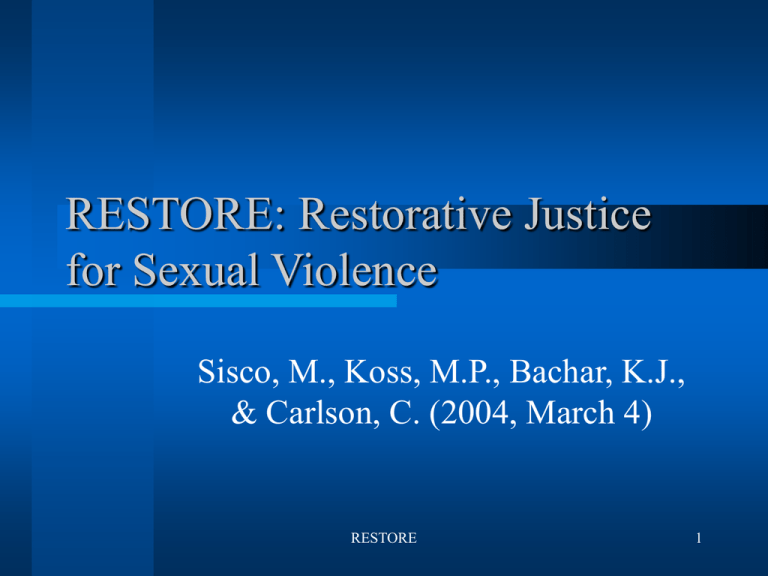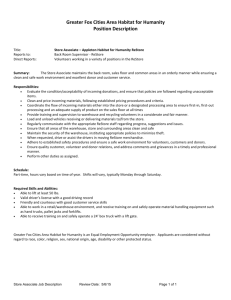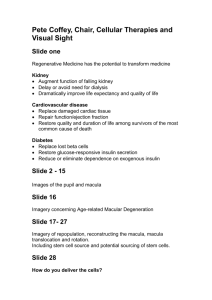
RESTORE: Restorative Justice
for Sexual Violence
Sisco, M., Koss, M.P., Bachar, K.J.,
& Carlson, C. (2004, March 4)
RESTORE
1
Project Affiliates
Collaborators: Southern Arizona Center
Against Sexual Assault, the Pima County
Attorney’s Office, the University of Arizona
College of Public Health, and Washington
and Lee School of Law
Funding
Agent: The Centers for Disease
Control and Prevention (R49CCR921 709-01)
RESTORE
2
Project Goals
Allowing victim-focused intervention
Creating offender accountability
Correcting problems in the
traditional response to sex offenses
Preventing further violence
RESTORE
3
Restorative Justice
Restorative
Justice Interventions
focus on repairing the harm caused
by crime. This harm impacts the
victim and the community.
-Existing applications: Community Courts,
Sentencing Councils, Restitution Programs,
Victim Impact Classes, Community Service.
Fairness: 97% conferenced / 79% traditional (McCold & Wachtel,1998)
Satisfaction: 90% conferenced/ 68% traditional (McGarrel, 2000)
RESTORE
4
THE RESTORE
PROCESSAIM OF
RESTORE
RESTORE
5
RESTORE Eligibility
Both persons must:
– Be fully competent
– Consent to participate
Responsible
person MUST ACKNOWLEDGE
FULL RESPONSIBILITY.
Responsible person must not have:
–been convicted of a felony within statute of
limitations mandated by the state (AZ Statute 13-107)
–committed interpersonal violence; past or present
–used weapons or severe violence in current case
–drugged the victim
RESTORE
6
RESTORE: Overview
Referral
Preparation
Conferencing
Supervision
Community Accountability
Outcome
RESTORE
7
Time Line
Consent & Preparation
Conference
Supervision
1-3 months
1 day
RESTORE
12 months
8
Traditional justice problems
1. Low rates of reporting: A recent study found only 2.1%
of rapes reported to the police (Fisher et. al, 2003)
2. Low conviction rate for rape: 9.6% in 2000 in Pima
County (Pima Co. Interagency council, 2001)
3. High rates of recidivism: 39% of rapists reoffended in 25
year period (Prentky et al., 1997)
4. Adversarial process perceived negatively by the victims
with low moral satisfaction (Koss et al., in press)
RESTORE
9
RESTORE vs. Traditional
Crime violates people and
relationships
Crime violates laws and the state
The victim is central to defining
harm
The victim is peripheral to the
process
Repairing social injury is the
focus
One social injury (jail) replaces
another (crime)
Focus on responsibility and
repair
Focus on blame and adversarial
resolution
Community is active
Community is abstractly
represented by state
Punishment encourages
remorse, repairing victim, and
improving offender’s lawabiding resources.
Punishment causes discomfort
and separates from society
RESTORE
10
Research Aims
Aim 1- Theory-driven program
evaluation of RESTORE and develop
a logic model
Aim 2- RESTORE’s impact on system
case processing and recidivisim rate
Aim 3- Outcome evaluation on sexual
violence perpetration
RESTORE
11
Responsibility and Equity for Sexual Transgressions
Offering a Restorative Experience
FOR MORE INFO...
Call (520) 626-9511 or view
http://restoreprogram.publichealth.arizona.edu/
RESTORE
12
Related Documents
Bazemore, G. Principles of Restorative Justice. Presentation:
July 25, 2001.
Fisher, B. S., Daigle, L. E., Cullen, F. T., & Turner, M. G. (2003).
Reporting sexual victimization to the police and others: Results
from a national-level study of college women. Criminal Justice &
Behavior, 30 (1), 6-38.
Frazier, P.A., & Haney, B. (1996). Sexual assault cases in the
legal system: Police, prosecutor, and victim perspectives. Law
and Human Behavior, 20, 607-628.
Koss, M.P., Bachar, K.J., & Hopkins, C.Q. (2003). Restorative
justice for sexual violence: Repairing victims, building
community, and holding offenders accountable. Annals New
York Academy of Sciences, 989, 384-306.
RESTORE
13
Related Documents (continued)
Koss, M.P., Bachar, K.J., Hopkins, C.Q., Carlson, C. (2004) Expanding
a Community’s Justice Response to Sex Crimes through Advocacy,
Prosecutorial, and Public Health Collaboration: Introducing the
RESTORE program . (in press).
Koss, M.P., Bachar, K.J., Hopkins, C.Q., Carlson, C. (2004) Justice
responses to sexual assault: Lessons learned and new directions.
Journal of Interpersonal Violence (in press).
McCahill, T.W., Meyer, L.C., & Fischman, A.M. (1979). The aftermath
of rape. Lexington, MA: D.C. Health.
McCold, P., & Wachtel, B. (1998). Restorative policing experiment:
The Bethlehem Pennsylvania Police Family Group Conferencing
Project. Pipersville, PA: Community Service Foundation.
McGarrell, E.F. (2001). Restorative justice conference as an early
response to young offenders (NCJ 187769). Washington, DC: Office of
Juvenile Justice and Delinquency Prevention, U.S., Department of
Justice.
RESTORE
14
Related Documents (continued)
McCold, P., & Wachtel, T. (2002). Restorative justice theory
validation. In E. G. M. Weitekamp & H. J. Kerner (Eds.)
Restorative justice: theoretical foundations (pp. 110-142).
Devon, UK: Willan Publishing.
Pima County Interagency Council. (2001). Report Compiled by
Pima County Attorney’s Office for PCIC. Tucson, AZ.
Prentky, R.A., Lee, A.F., Knight, R.A., & Cerce, D. (1997).
Recidivism rates among child molesters and rapists: a
methodological analysis. Law and Human Behavior,21, 635659.
RESTORE
15
Related Documents (continued)
Tjaden, P. & Thoennes, N. (1998). Prevalence, incidence,
and consequences of violence against women: Findings
from the National Violence Against Women Survey
(National Institute of Justice Centers for Disease Control
and Prevention Research in Brief, Report
Umbreit, M. S., Coates, R. B., & Kalanj, B. (1994). Victim
meets offender: The impact of restorative justice and
mediation. Monsey, NY: Willow Tree Press, Inc.
RESTORE
16






